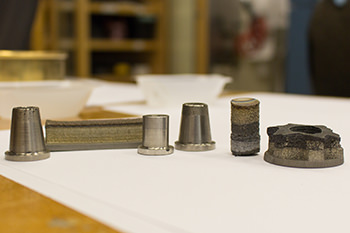
[Image above] Amit Bandyopadhyay displays a 3-D printed bimetallic sample. Credit: Washington State University
Additive manufacturing, or 3-D printing, has come a long way since the 1980s (yes, it’s been around since then!). Advances in technology have lowered barriers to entry and opened up opportunities for manufacturers in a variety of industries and sectors to lower fabrication costs and provide customized designs for customers, among other benefits.
And research has demonstrated that just about any material can be run through a 3-D printer: molten glass, ceramics, ink with silver flakes, and even concrete.
In all of these examples, researchers were limited to one type of material that they could put through the printer. But that’s about to change.
In new research, scientists from Washington State University have created a structure out of two different materials using a 3-D printer. Led by Herman and Brita Lindholm Endowed Chair Professor in the School of Mechanical and Materials Engineering and ACerS Fellow Amit Bandyopadhyay, the research team printed a ceramic and metal structure along with a bimetallic tube that is magnetic at one end and nonmagnetic at the other, according to a Washington State University news release.
“This is a step towards the next level of manufacturing and the next generation of design, validation, optimization, and manufacturing using 3-D printing,” Bandyopadhyay says in the release.
Bandyopadhyay explains that when manufacturers fabricate products consisting of more than one material, they typically use some type of adhesive to strengthen the joints. But even when two materials with high-strength properties are joined, they could still fail at the joint.
“You could be joining two very strong materials together, but their connection will only be as strong as their adhesive,” Bandyopadhyay adds in the release. “Multimaterial, additive manufacturing helps get rid of the weak point.”
The researchers used a nickel-chromium alloy (Inconel 718) and copper to make their sample product—in this case, an object that could be used in rockets or airplane engines. Using a method called laser engineering net shaping (LENS), they 3-D laser-printed the two materials together, resulting in a final object containing critical properties of both materials: The high-temperature tolerance of nickel-chromium and the fast-cooling property of copper. And, according to the paper, the bimetallic structures they printed increased in diffusivity by 250% and in conductivity by 300%.

Multimaterial samples printed by Washington State University researchers. Multimaterial 3-D printed designs can eliminate the need for adhesives and allow for greater design variety and specificity. Credit: Washington State University
Bandyopadhyay mentions that they are securing patents for their process. “At present, there are a couple of U.S. patents that are pending based on our technology,” he writes in an email.
Their research could have huge implications for additive manufacturing using multiple materials in one process and could very well replace welding and other materials joining technologies. “Applications are very broad,” Bandyopadhyay adds in his email. “Today, we use welding or brazing to make multi-materials parts. Our approach shows how to avoid such joining technologies and use a one-step process to make multi-material parts.”
The paper, published in Additive Manufacturing, is “Additive manufacturing of Inconel 718—Copper alloy bimetallic structure using laser engineered net shaping (LENS™)” (DOI: 10.1016/j.addma.2018.02.007).
Want to read more articles like this? Subscribe to the Ceramic Tech Today newsletter to continue to receive the latest news in the ceramic and glass industry right in your inbox! Visit this link to get started.
